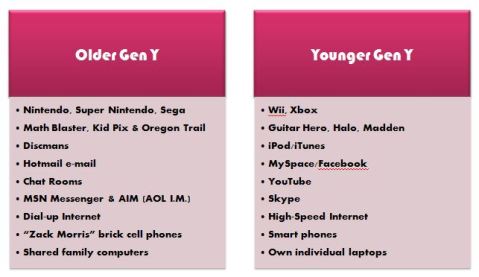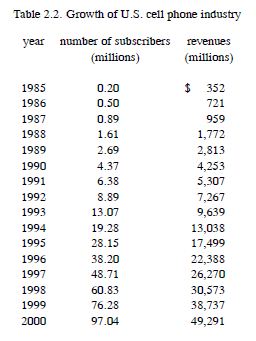Minding the Gaplet: Separating Older from Younger in Generation Y
Separating Gen Y into two groups are some drastic differences. It’s Nintendo vs. Guitar Hero, Discmans vs. iPods, Chat rooms vs. Skype and B.T. (Before Texting) vs. A.T. (Always Texting). The word coined to describe this schism between older and younger Gen Yers is “gaplet.”
 The gaplet was first mentioned in the retail and generational marketing book, Gen Buy, (Yarrow & O’Donnell, 2009) and helps explain key differences between the first decade of Gen Yers (born 1978 – 1987) and the second decade (1988-2000). The USA Today article, “Gen Y forces retailers to keep up with technology, new stuff,” also found the gaplet intriguing.
The gaplet was first mentioned in the retail and generational marketing book, Gen Buy, (Yarrow & O’Donnell, 2009) and helps explain key differences between the first decade of Gen Yers (born 1978 – 1987) and the second decade (1988-2000). The USA Today article, “Gen Y forces retailers to keep up with technology, new stuff,” also found the gaplet intriguing.
“One of the book’s most intriguing findings is the ‘gaplet’ between Gen Yers over 20 and under 20*, which makes it hard for retailers to aim messages at the entire group,” writer Richard Eisenberg notes. (*Keep in mind the over- under- comparison is only good for a few years — as Gen Y matures, the ages of those above and below the gaplet will change.)
For this Gen Yer, I’ve seen the split play out in my own life. I’m 26, born in 1983, but my younger brother is 20, born in 1989. I got a cell phone when I started driving – well more accurately, when I started working and drove a little early to my lawn mowing gigs – so about 15 years old. My brother got a cell phone when he was about 12. I didn’t know how to text until a few years later, and didn’t really begin text mania until college in 2002. He grew up with texting thumb.
(Random musing: When we have white hair, will we be telling our kids about how we used to get in such big trouble for going over our texting limit or minutes?)
Cell phones are just one of the many points of demarcation between younger and older, but nearly all of it goes back to either technology or views on money.
The Cell Phone Gap
Before the text revolution started, and teenagers forgot how to say real words to each other, we had cell phones that (gasp!) didn’t text. From 1994 on, cell phone usage skyrocketed – nearly doubling in those years. While oldest Gen Yers (born in 1978) were already 16 by the time cell phones took off, those near the middle (1988) were only 6 years old. In fact, my first cell phone (a hand-me-down from my Mom) was this lovely Motorola . I called it the Elephant. It was large and in charge. I remember the switch from analog cell phone to digital (the screens got cooler) and later on in college in the early 2000s, the switch to a multicolored cell phone screen.
Now, two-thirds of 15 to 17 year olds prefer texting to email, though among 25 to 34 year olds, 75 percent prefer email to texting (Exact Target 2008 Channel Preference Survey).
What that means for Gen Yers in different age groups is a different level of connectivity with the world. Being able to plan a day on an hourly basis – when should Mom pick me up? How long will basketball practice run? What time should friends come over? – is a big difference from the days when you planned out the weekend entire days in advance. It makes younger Gen Yers more flexible and able to shift gears quickly, whether at work or in one’s personal life.
Hyperactivity & Warp Speeds Online
When the Internet got faster, our attention spans got shorter. Though all digitally native Gen Yers are known for processing vast amounts of information quickly, the younger gen processes in hyperspeed. I still remember using a card catalog (you know, the paper kind) and doing research in books. I didn’t really use electronic versions of scholarly articles until college. My brother has always done his research online.
High-impact stimulation, from video games to online experiences, are expected by younger Gen Yers. Older Gen Yers are a little more patient online, maybe because our first online experiences included waiting for the dial-up to kick in (Remember that noise? A dial tone, a little bit of screetching, white noise and finally…connection!).
Videos weren’t even possible in early days of the Internet. YouTube was born in 2005, so well into the college years for most older Gen Yers. Older Gen Yers still recorded things on the VCR, but younger Gen Yers either found the show online, downloaded it to their iPods or just DVR-ed it.
Social Skills and Living Out Loud Online
Younger Gen Yers and especially the generation below us, Gen Z (Tweens), live on social networks. I volunteer with a local youth group of high schoolers, and they told me the law is: “If it isn’t on Facebook, it didn’t happen.”
While critics and parents are concerned social networking means we are losing face-to-face social skills, I’m not that worried about it — we are in school or at work all day face-to-face. I am worried about the fighting, bullying and squabbling that happens on all sorts of social networks and via text.
How many times do we as adults go back and forth over snarky emails, only to find out that the person we’re dialoging with “didn’t mean it like that?” When you’re a teen, everything is angst-ridden, hormones are raging and feelings are hurt with just a click of a mouse.
Living lives out loud online means kids are learning quickly to guard themselves and their private info online. Here’s an example.
Upon skimming my brother’s Facebook profile, I became alarmed when his relationship status wasn’t listed – after all, he had been seeing his high school girlfriend for over a year at that point. When I called him frantically wondering what had happened, his response was basically, “Sis, chill. I just don’t have it online. It’s nobody’s business.” Theirs was a typical on-again, off-again college relationship, and already my brother was showing a bit of wisdom in not broadcasting issues online.
I’m actually in awe of younger Gen Yers who had to deal with the Facebook phenomenon in high school. I was already awkward and self-conscious enough at that age – I can’t imagine having to re-live the stupid things I did online in a YouTube video or in a Facebook photo gallery.
Most Gen Yers are cognizant of online pressures to craft an “image.” Back in the day, you guarded your “rep” (reputation) by making sure others weren’t talking behind your back. Now, cyberspace allows Gen Yers to carefully craft an image. However, that’s not always positive – it can be superficial, hollow and controlled, and doesn’t allow young people to form meaningful connections to others.
“It’s harder to reshape and grow in your identity if you’re always part of past groups,” Gen Buy‘s authors note.
It’s a complex world for young people today. How much to reveal and what to reveal, are very serious concerns – and one that the youngest Gen Yers aren’t even cognizant of, it’s so natural to them. Some older Gen Yers choose not to be on Facebook, or to have a very limited personal presence. It’s a small difference, but with telling implications about the gaplet between the groups.
Children of Excess
 Many older Gen Yers are the ones who already had to come to terms with changes in lifestyle compared to their childhood and teen years. We learned our consumption habits in late childhood and teens – the children of 80’s excess lived on parents’ incomes (inflated home equity?!) and used credit cards like there was no tomorrow. Many quintessential 80’s/early 90’s movies showcased this excess – Cher in Clueless being a prime example.
Many older Gen Yers are the ones who already had to come to terms with changes in lifestyle compared to their childhood and teen years. We learned our consumption habits in late childhood and teens – the children of 80’s excess lived on parents’ incomes (inflated home equity?!) and used credit cards like there was no tomorrow. Many quintessential 80’s/early 90’s movies showcased this excess – Cher in Clueless being a prime example.
However, in Gen Buy researchers noticed marked differences and expectations between over 22 and under 22 age groups. The older, they said, were less prone to extravagance and were already cutting back before the 2008 recession.
Now what happens when any jobs, especially entry level jobs that Gen Yers fill – are more scarce and paychecks are slim? Older Gen Yers shifted down very quickly – or at least try to. Soaring credit card bills and debt are real, current issues for Gen Yers.
The age of online shopping didn’t hit until the oldest Gen Yers had some degree of independence – we had jobs and some disposable income, and didn’t need Mom to take us to the mall. Younger Gen Yers were teenagers when online shopping really took off. A world of products opened up when online retail destinations debuted, making younger Gen Yers pros at online consumerism. Formerly unreachable designer and luxury products (led by status bags, sunglasses, shoes & sneakers and gadgets) boomed when status-conscious teens got access to them.
“I see young kids with $300 jeans and Coach bags,” said a 25-year-old woman in Gen Buy. Implications for retail are already clear: Middle class kids with designer taste gave rise to cheap chic designer lines like Jimmy Choo for H&M and Zac Possen for Target. One of the biggest trends of the 2000’s is better design for the masses – whether that’s clothing, home goods or electronics – and it’s largely motivated by the buying power of Gen Y.
Gaplet Implications
The gaplet matters, or it should, for everyone from marketers to organizational management specialists. Lump the two groups together and you risk isolating the other. Though there are many similarities between older and younger Gen Yers, the subtle but important differences between the groups will impact how each communicates, works and spends. Effective students of Generation Y will find a way to fine tune messages and processes to speak differently to these two groups.
—
Note: The book referenced in this post, Gen Buy, is one of the best generational studies books I’ve read in 2010. Though it’s in the context of retail, much of the sociology in the book (relationships, personality development, role models) has implications beyond shopping. I highly recommend it. For more info, see the YPulse interview with the authors of Gen Buy.


